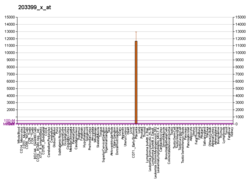| PSG3 | |||||||||||||||||||||||||||||||||||||||||||||||||||
|---|---|---|---|---|---|---|---|---|---|---|---|---|---|---|---|---|---|---|---|---|---|---|---|---|---|---|---|---|---|---|---|---|---|---|---|---|---|---|---|---|---|---|---|---|---|---|---|---|---|---|---|
| Identifiers | |||||||||||||||||||||||||||||||||||||||||||||||||||
| Aliases | PSG3, pregnancy specific beta-1-glycoprotein 3 | ||||||||||||||||||||||||||||||||||||||||||||||||||
| External IDs | OMIM: 176392; HomoloGene: 88876; GeneCards: PSG3; OMA:PSG3 - orthologs | ||||||||||||||||||||||||||||||||||||||||||||||||||
| |||||||||||||||||||||||||||||||||||||||||||||||||||
| |||||||||||||||||||||||||||||||||||||||||||||||||||
| |||||||||||||||||||||||||||||||||||||||||||||||||||
| Wikidata | |||||||||||||||||||||||||||||||||||||||||||||||||||
| |||||||||||||||||||||||||||||||||||||||||||||||||||
Pregnancy-specific beta-1-glycoprotein 3 is a protein that in humans is encoded by the PSG3 gene.
References
- ^ GRCh38: Ensembl release 89: ENSG00000221826 – Ensembl, May 2017
- "Human PubMed Reference:". National Center for Biotechnology Information, U.S. National Library of Medicine.
- Streydio C, Swillens S, Georges M, Szpirer C, Vassart G (Jun 1990). "Structure, evolution and chromosomal localization of the human pregnancy-specific beta 1 glycoprotein gene family". Genomics. 6 (4): 579–92. doi:10.1016/0888-7543(90)90492-D. PMID 2341148.
- "Entrez Gene: PSG3 pregnancy specific beta-1-glycoprotein 3".
Further reading
- Borjigin J, Tease LA, Barnes W, Chan WY (1990). "Expression of the pregnancy-specific beta 1-glycoprotein genes in human testis". Biochem. Biophys. Res. Commun. 166 (2): 622–9. doi:10.1016/0006-291X(90)90854-G. PMID 2302228.
- Zoubir F, Khan WN, Hammarström S (1990). "Carcinoembryonic antigen gene family members in submandibular salivary gland: demonstration of pregnancy-specific glycoproteins by cDNA cloning". Biochem. Biophys. Res. Commun. 169 (1): 203–16. doi:10.1016/0006-291X(90)91455-2. PMID 2350345.
- Streydio C, Swillens S, Georges M, et al. (1990). "Structure, evolution and chromosomal localization of the human pregnancy-specific beta 1-glycoprotein gene family". Genomics. 7 (4): 661–2. doi:10.1016/0888-7543(90)90216-H. PMID 2387594.
- McLenachan T, Mansfield B (1989). "Expression of CEA-related genes in the first trimester human placenta". Biochem. Biophys. Res. Commun. 162 (3): 1486–93. doi:10.1016/0006-291X(89)90842-5. PMID 2788412.
- Rooney BC, Horne CH, Hardman N (1989). "Molecular cloning of a cDNA for human pregnancy-specific beta 1-glycoprotein:homology with human carcinoembryonic antigen and related proteins". Gene. 71 (2): 439–49. doi:10.1016/0378-1119(88)90061-3. PMID 3265688.
- Olsen A, Teglund S, Nelson D, et al. (1995). "Gene organization of the pregnancy-specific glycoprotein region on human chromosome 19: assembly and analysis of a 700-kb cosmid contig spanning the region". Genomics. 23 (3): 659–68. doi:10.1006/geno.1994.1555. PMID 7851895.
- Shupert WL, Chan WY (1993). "Pregnancy specific beta 1-glycoprotein in human intestine". Mol. Cell. Biochem. 120 (2): 159–70. doi:10.1007/BF00926089. PMID 8487756. S2CID 35767792.
- Strausberg RL, Feingold EA, Grouse LH, et al. (2003). "Generation and initial analysis of more than 15,000 full-length human and mouse cDNA sequences". Proc. Natl. Acad. Sci. U.S.A. 99 (26): 16899–903. Bibcode:2002PNAS...9916899M. doi:10.1073/pnas.242603899. PMC 139241. PMID 12477932.
- Grimwood J, Gordon LA, Olsen A, et al. (2004). "The DNA sequence and biology of human chromosome 19". Nature. 428 (6982): 529–35. Bibcode:2004Natur.428..529G. doi:10.1038/nature02399. PMID 15057824.
- Colland F, Jacq X, Trouplin V, et al. (2004). "Functional proteomics mapping of a human signaling pathway". Genome Res. 14 (7): 1324–32. doi:10.1101/gr.2334104. PMC 442148. PMID 15231748.
- Gerhard DS, Wagner L, Feingold EA, et al. (2004). "The status, quality, and expansion of the NIH full-length cDNA project: the Mammalian Gene Collection (MGC)". Genome Res. 14 (10B): 2121–7. doi:10.1101/gr.2596504. PMC 528928. PMID 15489334.
- Rual JF, Venkatesan K, Hao T, et al. (2005). "Towards a proteome-scale map of the human protein-protein interaction network". Nature. 437 (7062): 1173–8. Bibcode:2005Natur.437.1173R. doi:10.1038/nature04209. PMID 16189514. S2CID 4427026.
- Kimura K, Wakamatsu A, Suzuki Y, et al. (2006). "Diversification of transcriptional modulation: large-scale identification and characterization of putative alternative promoters of human genes". Genome Res. 16 (1): 55–65. doi:10.1101/gr.4039406. PMC 1356129. PMID 16344560.
This article is a stub. You can help Misplaced Pages by expanding it. |


